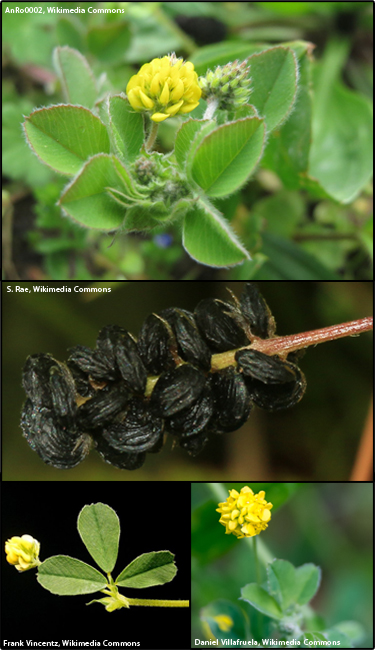Black medic (Medicago lupulina)
 Synonyms: Medicago lupulina var. cupaniana, Medicago lupulina var. glandulosa
Synonyms: Medicago lupulina var. cupaniana, Medicago lupulina var. glandulosaCommon Names: hop clover, hop medic, nonesuch, yellow trefoil
Description: Introduced to North America as a forage plant for livestock and for improving soil as early as the 1700s.
Habit: Low growing summer or winter annual broadleaf growing to about 1.6 feet tall.
Leaves: Alternate, compound, trifoliate.
Stems: Light green in color or reddish green, densely covered in white hairs.
Flowers: Yellow in color, clustered in groups of 15-20 flowers. Flowers are 0.13 inches (0.32 cm) long and clusters are 0.25 in. (0.64 cm) across.
Fruit and seeds: Each flower cluster is replaced by a dense cluster of seedpods. Dark colored, hairy, strongly curled and 0.13 in. (0.32 cm) long containing a single seed that is flattened and kidney-shaped.
Habitat: Native to Eurasia. Can be found in highly disturbed areas, prairies, cropland, pastures, railroads and roadsides.
Reproduction: By seed.
Monitoring and rapid response: Herbicides such as 2,4-Dichlorophenoxyacetic acid and dicamba have been used to manage this species in agricultural fields. Credits: The information provided in this factsheet was gathered from CABI: Invasive Species Compendium and the Invasive Plant Atlas of the United States.
Individual species images that appear with a number in a black box are courtesy of the Bugwood.org network (http://www.invasive.org).Individual photo author credits may not be included due to the small display size of the images and subsequent difficulty of reading the provided text. All other images appear courtesy of Google (http://images.google.com).
